Evaluating Reward Management's Impact on Employee Retention: Sainsbury
VerifiedAdded on 2020/06/06
|56
|9060
|57
Report
AI Summary
This report provides a comprehensive analysis of the impact of reward management on employee retention, using Sainsbury as a case study. The report begins with an introduction that outlines the research aim, objectives, background, problem, and purpose. It then delves into a literature review, exploring the concepts of employee retention, reward management, innovation processes for effective rewards, and maintaining brand image. The research methodology section details the research philosophy, design, approach, data collection and analysis methods, sampling techniques, and ethical considerations. The results and discussion chapter presents and interprets the data collected, including figures illustrating employee perceptions of financial and non-financial rewards, job satisfaction, and company culture. Finally, the report concludes with recommendations for improving employee retention through strategic reward management, emphasizing the importance of aligning rewards with employee needs and organizational goals. The report also includes figures, tables, references, and appendices that support the findings and conclusions.
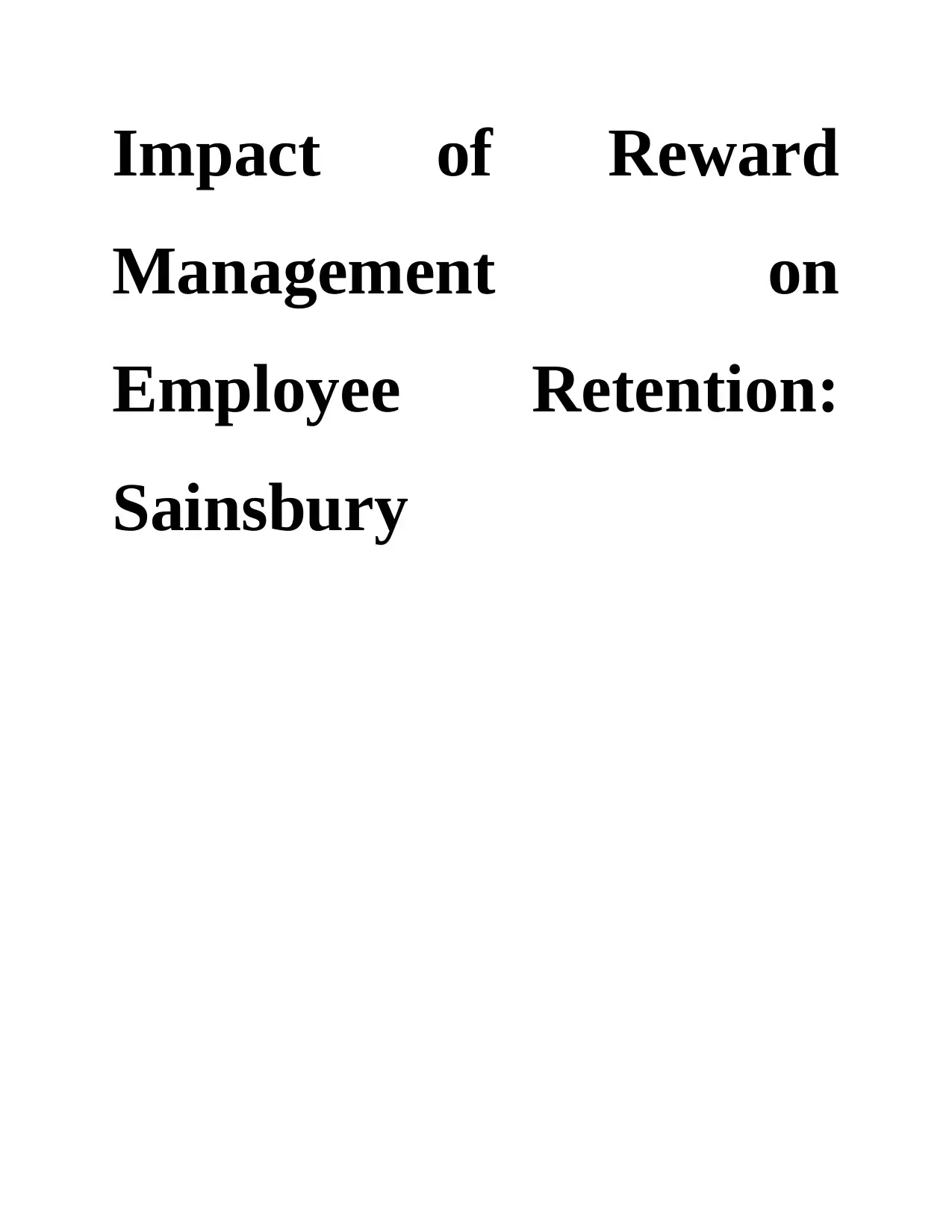
Impact of Reward
Management on
Employee Retention:
Sainsbury
Management on
Employee Retention:
Sainsbury
Paraphrase This Document
Need a fresh take? Get an instant paraphrase of this document with our AI Paraphraser

ABSTRACT
Retention of any employee would be meaning that what and how company is putting the
efforts in order to regain or make all employees stay within company for longer duration of time.
This is very much important in all the sense in respect of employee been able to work well, in
order to their productivity, their performance, profitability of company and ultimately
sustainability of company within market. All the above mentioned things are very much
significance in way firm is working with good and efficient people. Sainsbury is regarded as the
2nd largest supermarket brand in UK having about 16.9% shares in this sector which is owned by
Qatar investment with about 21.99% of shares of profit. The whole group is having 3 sub-
divisions which are bank, supermarket and Argos (which is providing utilities like that of gas and
energy service within whole market of UK). So in total company is having about 1.81 million
employees as on 2017 it becomes necessary for company to look forward about the retention
policy of Human Resource department of group. Reward system ensure that monitory and non-
monitory needs of the people can be fulfilled so that they feel happy in the organization and
perform their work effectively. Workers are the life blood of company as they directly interact
with customers. They are the one who present the products and services to people. In such
condition if they feel unhappy in the workplace then they do not deal with the consumers well.
This affects revenues of the entity and create difficulty for the firm to sustain in the market for
longer duration. Brand image is considered as essential and useful tool that assists in garbing the
attention of customers in market and helping them all to choose the best one from various others
in same market. With the help of good brand image of company they could easily be making
their customers retained within same firm which is termed to as brand loyalty.
Retention of any employee would be meaning that what and how company is putting the
efforts in order to regain or make all employees stay within company for longer duration of time.
This is very much important in all the sense in respect of employee been able to work well, in
order to their productivity, their performance, profitability of company and ultimately
sustainability of company within market. All the above mentioned things are very much
significance in way firm is working with good and efficient people. Sainsbury is regarded as the
2nd largest supermarket brand in UK having about 16.9% shares in this sector which is owned by
Qatar investment with about 21.99% of shares of profit. The whole group is having 3 sub-
divisions which are bank, supermarket and Argos (which is providing utilities like that of gas and
energy service within whole market of UK). So in total company is having about 1.81 million
employees as on 2017 it becomes necessary for company to look forward about the retention
policy of Human Resource department of group. Reward system ensure that monitory and non-
monitory needs of the people can be fulfilled so that they feel happy in the organization and
perform their work effectively. Workers are the life blood of company as they directly interact
with customers. They are the one who present the products and services to people. In such
condition if they feel unhappy in the workplace then they do not deal with the consumers well.
This affects revenues of the entity and create difficulty for the firm to sustain in the market for
longer duration. Brand image is considered as essential and useful tool that assists in garbing the
attention of customers in market and helping them all to choose the best one from various others
in same market. With the help of good brand image of company they could easily be making
their customers retained within same firm which is termed to as brand loyalty.
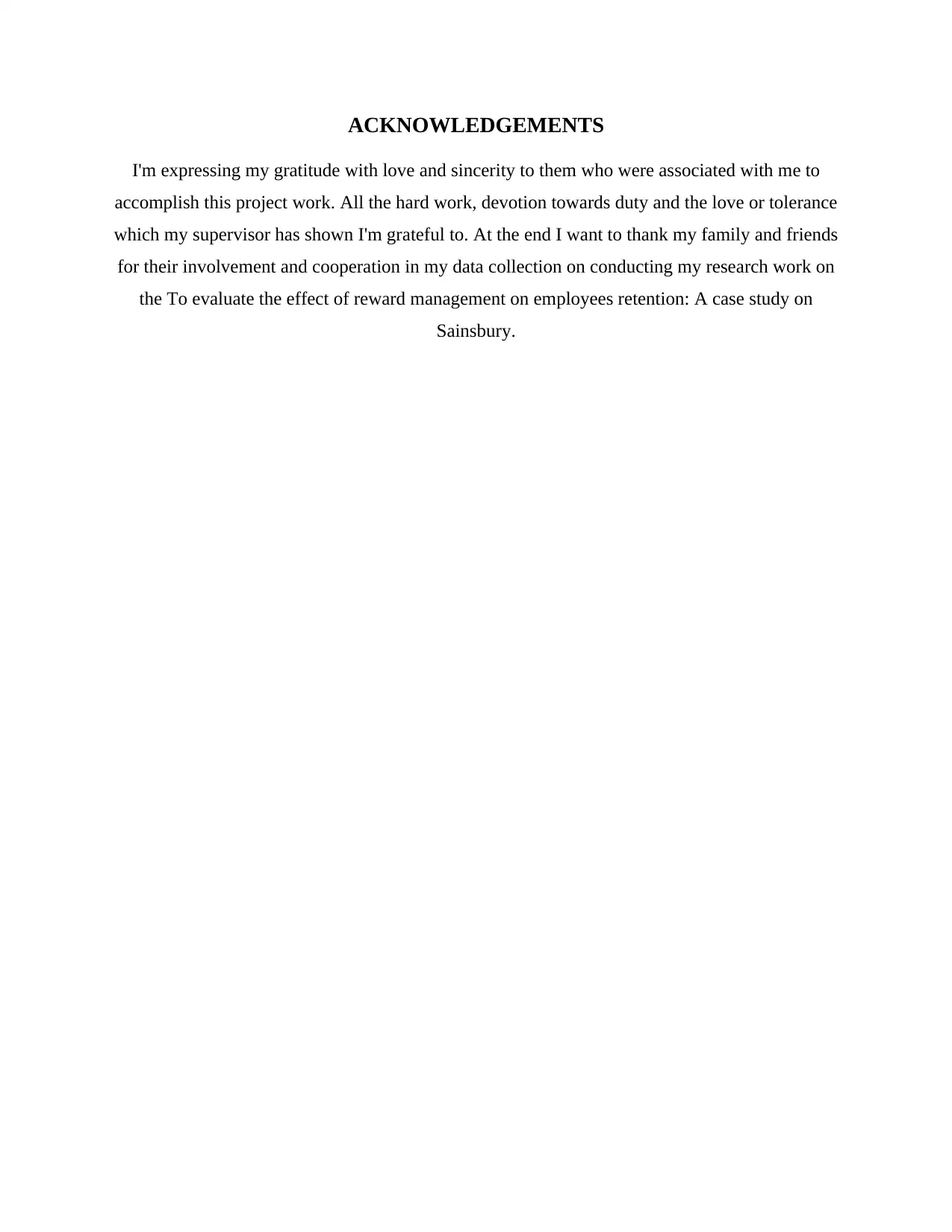
ACKNOWLEDGEMENTS
I'm expressing my gratitude with love and sincerity to them who were associated with me to
accomplish this project work. All the hard work, devotion towards duty and the love or tolerance
which my supervisor has shown I'm grateful to. At the end I want to thank my family and friends
for their involvement and cooperation in my data collection on conducting my research work on
the To evaluate the effect of reward management on employees retention: A case study on
Sainsbury.
I'm expressing my gratitude with love and sincerity to them who were associated with me to
accomplish this project work. All the hard work, devotion towards duty and the love or tolerance
which my supervisor has shown I'm grateful to. At the end I want to thank my family and friends
for their involvement and cooperation in my data collection on conducting my research work on
the To evaluate the effect of reward management on employees retention: A case study on
Sainsbury.
⊘ This is a preview!⊘
Do you want full access?
Subscribe today to unlock all pages.

Trusted by 1+ million students worldwide
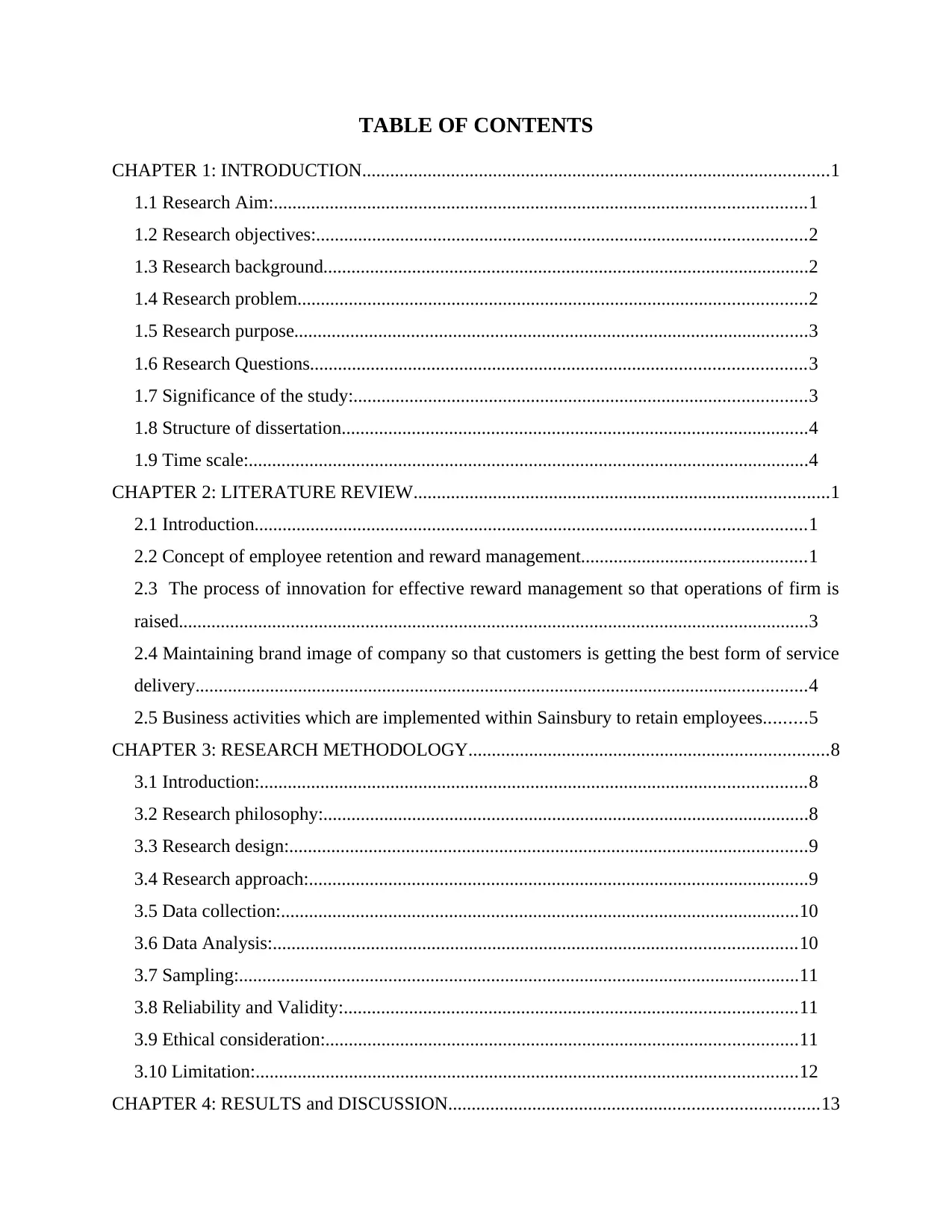
TABLE OF CONTENTS
CHAPTER 1: INTRODUCTION....................................................................................................1
1.1 Research Aim:..................................................................................................................1
1.2 Research objectives:.........................................................................................................2
1.3 Research background........................................................................................................2
1.4 Research problem.............................................................................................................2
1.5 Research purpose..............................................................................................................3
1.6 Research Questions..........................................................................................................3
1.7 Significance of the study:.................................................................................................3
1.8 Structure of dissertation....................................................................................................4
1.9 Time scale:........................................................................................................................4
CHAPTER 2: LITERATURE REVIEW.........................................................................................1
2.1 Introduction......................................................................................................................1
2.2 Concept of employee retention and reward management................................................1
2.3 The process of innovation for effective reward management so that operations of firm is
raised.......................................................................................................................................3
2.4 Maintaining brand image of company so that customers is getting the best form of service
delivery...................................................................................................................................4
2.5 Business activities which are implemented within Sainsbury to retain employees.........5
CHAPTER 3: RESEARCH METHODOLOGY.............................................................................8
3.1 Introduction:.....................................................................................................................8
3.2 Research philosophy:........................................................................................................8
3.3 Research design:...............................................................................................................9
3.4 Research approach:...........................................................................................................9
3.5 Data collection:...............................................................................................................10
3.6 Data Analysis:................................................................................................................10
3.7 Sampling:........................................................................................................................11
3.8 Reliability and Validity:.................................................................................................11
3.9 Ethical consideration:.....................................................................................................11
3.10 Limitation:....................................................................................................................12
CHAPTER 4: RESULTS and DISCUSSION...............................................................................13
CHAPTER 1: INTRODUCTION....................................................................................................1
1.1 Research Aim:..................................................................................................................1
1.2 Research objectives:.........................................................................................................2
1.3 Research background........................................................................................................2
1.4 Research problem.............................................................................................................2
1.5 Research purpose..............................................................................................................3
1.6 Research Questions..........................................................................................................3
1.7 Significance of the study:.................................................................................................3
1.8 Structure of dissertation....................................................................................................4
1.9 Time scale:........................................................................................................................4
CHAPTER 2: LITERATURE REVIEW.........................................................................................1
2.1 Introduction......................................................................................................................1
2.2 Concept of employee retention and reward management................................................1
2.3 The process of innovation for effective reward management so that operations of firm is
raised.......................................................................................................................................3
2.4 Maintaining brand image of company so that customers is getting the best form of service
delivery...................................................................................................................................4
2.5 Business activities which are implemented within Sainsbury to retain employees.........5
CHAPTER 3: RESEARCH METHODOLOGY.............................................................................8
3.1 Introduction:.....................................................................................................................8
3.2 Research philosophy:........................................................................................................8
3.3 Research design:...............................................................................................................9
3.4 Research approach:...........................................................................................................9
3.5 Data collection:...............................................................................................................10
3.6 Data Analysis:................................................................................................................10
3.7 Sampling:........................................................................................................................11
3.8 Reliability and Validity:.................................................................................................11
3.9 Ethical consideration:.....................................................................................................11
3.10 Limitation:....................................................................................................................12
CHAPTER 4: RESULTS and DISCUSSION...............................................................................13
Paraphrase This Document
Need a fresh take? Get an instant paraphrase of this document with our AI Paraphraser

4.1 Introduction:...................................................................................................................13
4.2 Data collection and interpretation:.................................................................................13
CHAPTER 5: CONCLUSION and RECOMMENDATIONS......................................................31
5.1 Conclusion:.....................................................................................................................31
5.2 Recommendations:.........................................................................................................32
REFERENCES..............................................................................................................................35
APPENDIX....................................................................................................................................39
4.2 Data collection and interpretation:.................................................................................13
CHAPTER 5: CONCLUSION and RECOMMENDATIONS......................................................31
5.1 Conclusion:.....................................................................................................................31
5.2 Recommendations:.........................................................................................................32
REFERENCES..............................................................................................................................35
APPENDIX....................................................................................................................................39

TABLE OF FIGURES
Figure 1: Length of working into the company with current employer........................................15
Figure 2: Non-financial rewards into the job.................................................................................16
Figure 3: Desiring to get the non-financial reward at work...........................................................17
Figure 4: Salary and rise in the pay after good performance.........................................................19
Figure 5: Satisfaction with current financial policy of rewarding into company..........................20
Figure 6: Satisfaction with the promotional opportunities in company........................................21
Figure 7: Supervisor is encouraging on good performance...........................................................22
Figure 8: They are informing about the changes in organisation..................................................23
Figure 9: They are giving positive feedback on employee without any biasness.........................24
Figure 10: They are supportive in work done................................................................................24
Figure 11: Sense of fulfilment after completion of work..............................................................26
Figure 12: Acceptance of all challenges at work...........................................................................27
Figure 13: Sense of belongingness with the company...................................................................27
Figure 14: Service delivery is as per customer expectation..........................................................29
Figure 15: Quality of service keeps customers loyal and hence repeated visits take place...........30
Figure 16: Employees are trained in their respective functional areas..........................................31
Figure 17: Learning and development...........................................................................................32
Figure 18: Job security...................................................................................................................33
Figure 19: Often think about quitting current job as soon as possible..........................................33
Figure 1: Length of working into the company with current employer........................................15
Figure 2: Non-financial rewards into the job.................................................................................16
Figure 3: Desiring to get the non-financial reward at work...........................................................17
Figure 4: Salary and rise in the pay after good performance.........................................................19
Figure 5: Satisfaction with current financial policy of rewarding into company..........................20
Figure 6: Satisfaction with the promotional opportunities in company........................................21
Figure 7: Supervisor is encouraging on good performance...........................................................22
Figure 8: They are informing about the changes in organisation..................................................23
Figure 9: They are giving positive feedback on employee without any biasness.........................24
Figure 10: They are supportive in work done................................................................................24
Figure 11: Sense of fulfilment after completion of work..............................................................26
Figure 12: Acceptance of all challenges at work...........................................................................27
Figure 13: Sense of belongingness with the company...................................................................27
Figure 14: Service delivery is as per customer expectation..........................................................29
Figure 15: Quality of service keeps customers loyal and hence repeated visits take place...........30
Figure 16: Employees are trained in their respective functional areas..........................................31
Figure 17: Learning and development...........................................................................................32
Figure 18: Job security...................................................................................................................33
Figure 19: Often think about quitting current job as soon as possible..........................................33
⊘ This is a preview!⊘
Do you want full access?
Subscribe today to unlock all pages.

Trusted by 1+ million students worldwide
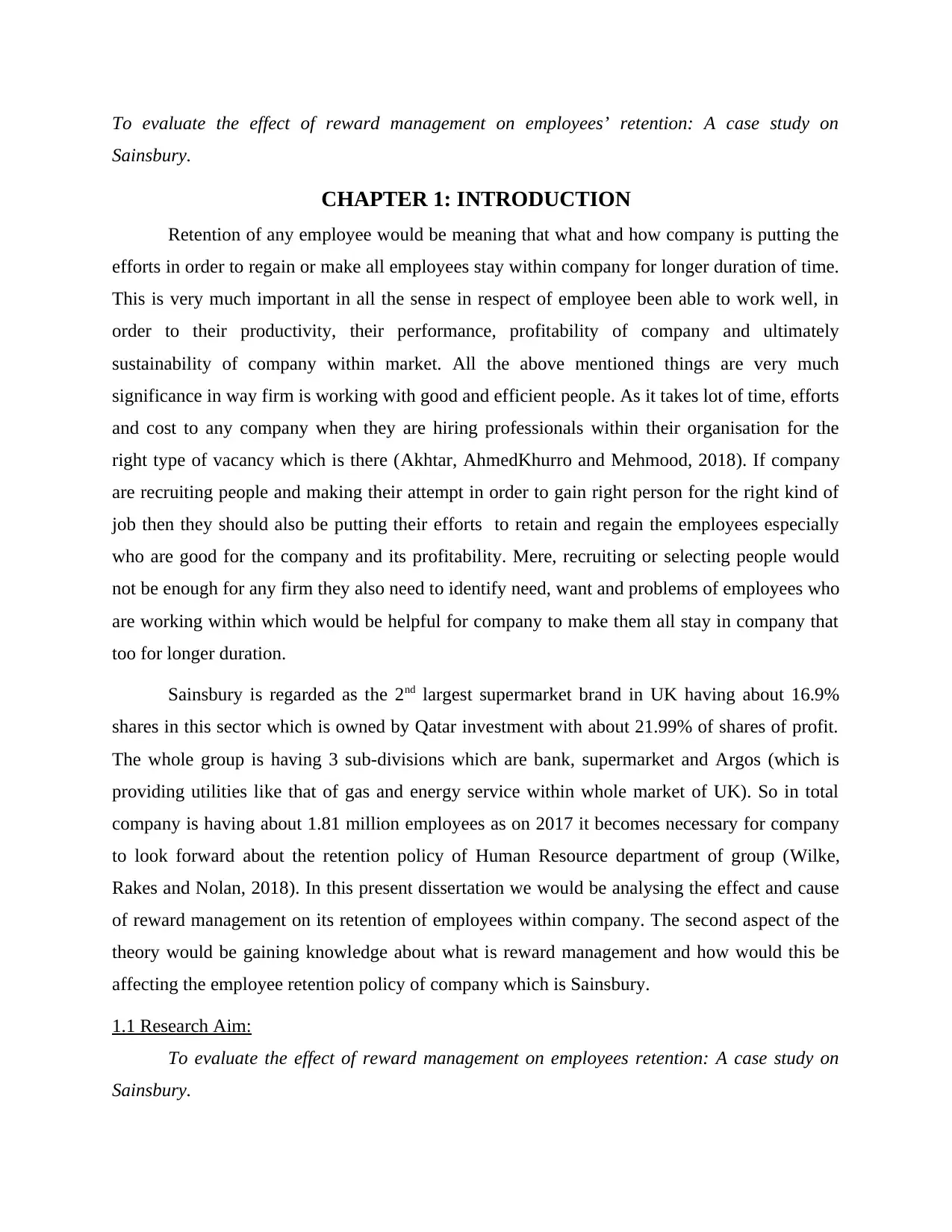
To evaluate the effect of reward management on employees’ retention: A case study on
Sainsbury.
CHAPTER 1: INTRODUCTION
Retention of any employee would be meaning that what and how company is putting the
efforts in order to regain or make all employees stay within company for longer duration of time.
This is very much important in all the sense in respect of employee been able to work well, in
order to their productivity, their performance, profitability of company and ultimately
sustainability of company within market. All the above mentioned things are very much
significance in way firm is working with good and efficient people. As it takes lot of time, efforts
and cost to any company when they are hiring professionals within their organisation for the
right type of vacancy which is there (Akhtar, AhmedKhurro and Mehmood, 2018). If company
are recruiting people and making their attempt in order to gain right person for the right kind of
job then they should also be putting their efforts to retain and regain the employees especially
who are good for the company and its profitability. Mere, recruiting or selecting people would
not be enough for any firm they also need to identify need, want and problems of employees who
are working within which would be helpful for company to make them all stay in company that
too for longer duration.
Sainsbury is regarded as the 2nd largest supermarket brand in UK having about 16.9%
shares in this sector which is owned by Qatar investment with about 21.99% of shares of profit.
The whole group is having 3 sub-divisions which are bank, supermarket and Argos (which is
providing utilities like that of gas and energy service within whole market of UK). So in total
company is having about 1.81 million employees as on 2017 it becomes necessary for company
to look forward about the retention policy of Human Resource department of group (Wilke,
Rakes and Nolan, 2018). In this present dissertation we would be analysing the effect and cause
of reward management on its retention of employees within company. The second aspect of the
theory would be gaining knowledge about what is reward management and how would this be
affecting the employee retention policy of company which is Sainsbury.
1.1 Research Aim:
To evaluate the effect of reward management on employees retention: A case study on
Sainsbury.
Sainsbury.
CHAPTER 1: INTRODUCTION
Retention of any employee would be meaning that what and how company is putting the
efforts in order to regain or make all employees stay within company for longer duration of time.
This is very much important in all the sense in respect of employee been able to work well, in
order to their productivity, their performance, profitability of company and ultimately
sustainability of company within market. All the above mentioned things are very much
significance in way firm is working with good and efficient people. As it takes lot of time, efforts
and cost to any company when they are hiring professionals within their organisation for the
right type of vacancy which is there (Akhtar, AhmedKhurro and Mehmood, 2018). If company
are recruiting people and making their attempt in order to gain right person for the right kind of
job then they should also be putting their efforts to retain and regain the employees especially
who are good for the company and its profitability. Mere, recruiting or selecting people would
not be enough for any firm they also need to identify need, want and problems of employees who
are working within which would be helpful for company to make them all stay in company that
too for longer duration.
Sainsbury is regarded as the 2nd largest supermarket brand in UK having about 16.9%
shares in this sector which is owned by Qatar investment with about 21.99% of shares of profit.
The whole group is having 3 sub-divisions which are bank, supermarket and Argos (which is
providing utilities like that of gas and energy service within whole market of UK). So in total
company is having about 1.81 million employees as on 2017 it becomes necessary for company
to look forward about the retention policy of Human Resource department of group (Wilke,
Rakes and Nolan, 2018). In this present dissertation we would be analysing the effect and cause
of reward management on its retention of employees within company. The second aspect of the
theory would be gaining knowledge about what is reward management and how would this be
affecting the employee retention policy of company which is Sainsbury.
1.1 Research Aim:
To evaluate the effect of reward management on employees retention: A case study on
Sainsbury.
Paraphrase This Document
Need a fresh take? Get an instant paraphrase of this document with our AI Paraphraser
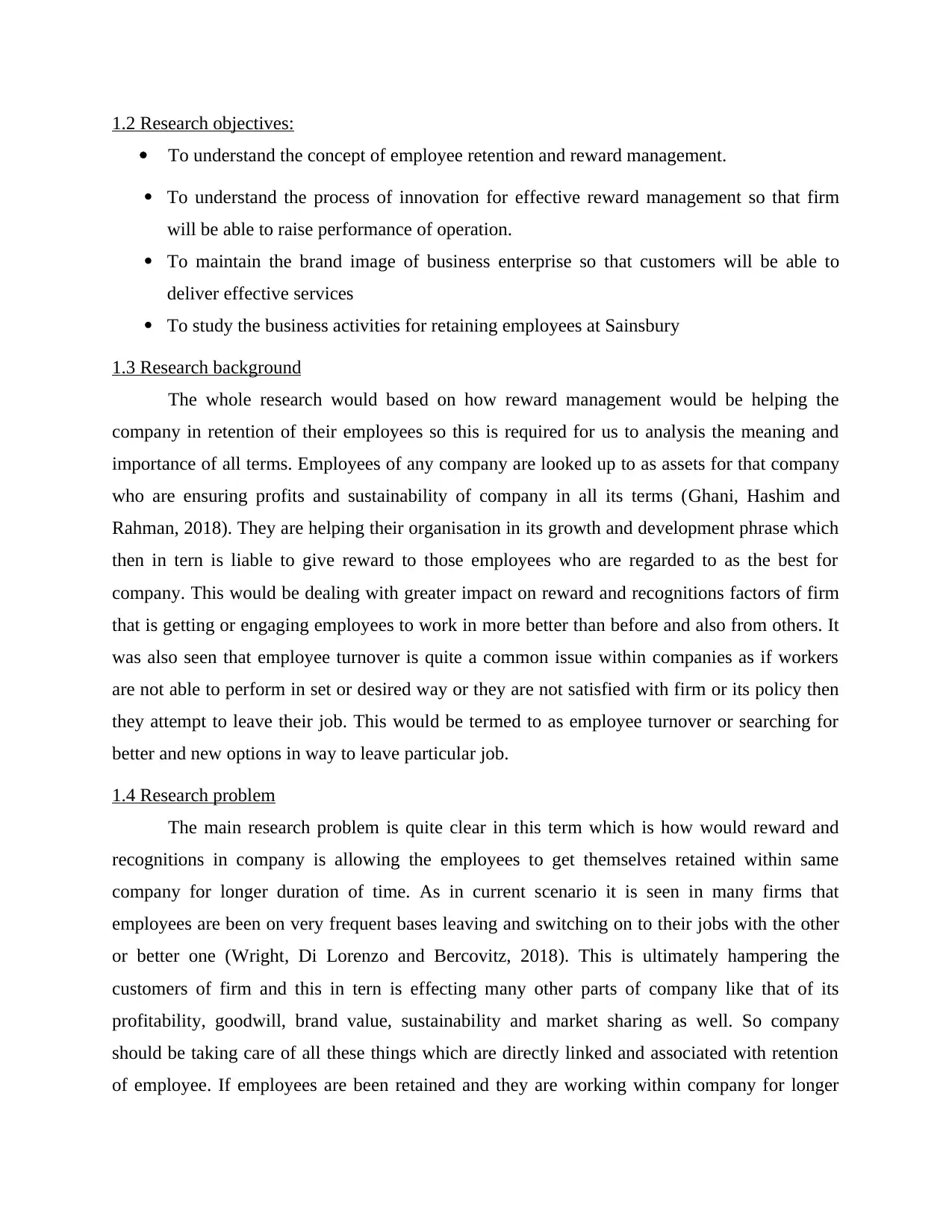
1.2 Research objectives:
To understand the concept of employee retention and reward management.
To understand the process of innovation for effective reward management so that firm
will be able to raise performance of operation.
To maintain the brand image of business enterprise so that customers will be able to
deliver effective services
To study the business activities for retaining employees at Sainsbury
1.3 Research background
The whole research would based on how reward management would be helping the
company in retention of their employees so this is required for us to analysis the meaning and
importance of all terms. Employees of any company are looked up to as assets for that company
who are ensuring profits and sustainability of company in all its terms (Ghani, Hashim and
Rahman, 2018). They are helping their organisation in its growth and development phrase which
then in tern is liable to give reward to those employees who are regarded to as the best for
company. This would be dealing with greater impact on reward and recognitions factors of firm
that is getting or engaging employees to work in more better than before and also from others. It
was also seen that employee turnover is quite a common issue within companies as if workers
are not able to perform in set or desired way or they are not satisfied with firm or its policy then
they attempt to leave their job. This would be termed to as employee turnover or searching for
better and new options in way to leave particular job.
1.4 Research problem
The main research problem is quite clear in this term which is how would reward and
recognitions in company is allowing the employees to get themselves retained within same
company for longer duration of time. As in current scenario it is seen in many firms that
employees are been on very frequent bases leaving and switching on to their jobs with the other
or better one (Wright, Di Lorenzo and Bercovitz, 2018). This is ultimately hampering the
customers of firm and this in tern is effecting many other parts of company like that of its
profitability, goodwill, brand value, sustainability and market sharing as well. So company
should be taking care of all these things which are directly linked and associated with retention
of employee. If employees are been retained and they are working within company for longer
To understand the concept of employee retention and reward management.
To understand the process of innovation for effective reward management so that firm
will be able to raise performance of operation.
To maintain the brand image of business enterprise so that customers will be able to
deliver effective services
To study the business activities for retaining employees at Sainsbury
1.3 Research background
The whole research would based on how reward management would be helping the
company in retention of their employees so this is required for us to analysis the meaning and
importance of all terms. Employees of any company are looked up to as assets for that company
who are ensuring profits and sustainability of company in all its terms (Ghani, Hashim and
Rahman, 2018). They are helping their organisation in its growth and development phrase which
then in tern is liable to give reward to those employees who are regarded to as the best for
company. This would be dealing with greater impact on reward and recognitions factors of firm
that is getting or engaging employees to work in more better than before and also from others. It
was also seen that employee turnover is quite a common issue within companies as if workers
are not able to perform in set or desired way or they are not satisfied with firm or its policy then
they attempt to leave their job. This would be termed to as employee turnover or searching for
better and new options in way to leave particular job.
1.4 Research problem
The main research problem is quite clear in this term which is how would reward and
recognitions in company is allowing the employees to get themselves retained within same
company for longer duration of time. As in current scenario it is seen in many firms that
employees are been on very frequent bases leaving and switching on to their jobs with the other
or better one (Wright, Di Lorenzo and Bercovitz, 2018). This is ultimately hampering the
customers of firm and this in tern is effecting many other parts of company like that of its
profitability, goodwill, brand value, sustainability and market sharing as well. So company
should be taking care of all these things which are directly linked and associated with retention
of employee. If employees are been retained and they are working within company for longer
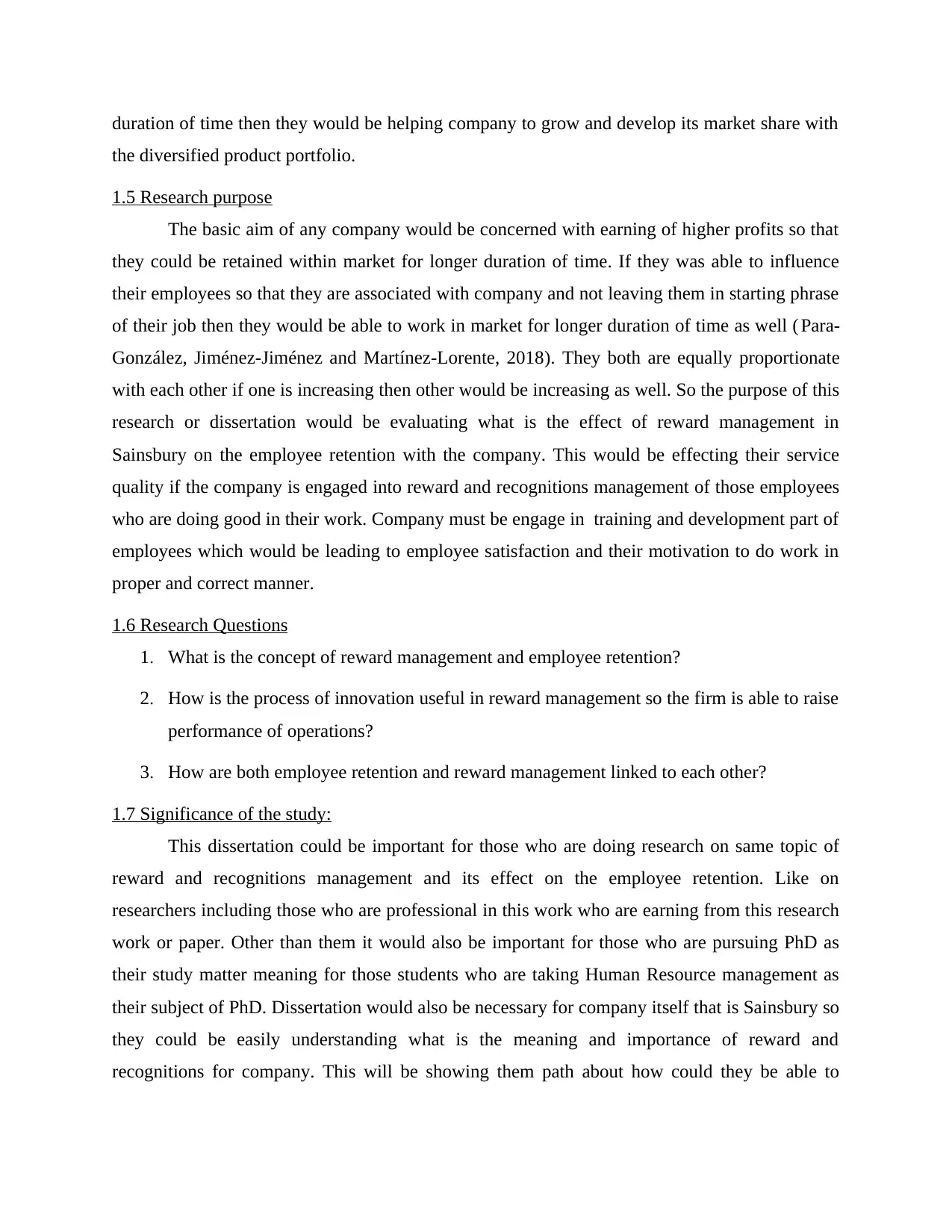
duration of time then they would be helping company to grow and develop its market share with
the diversified product portfolio.
1.5 Research purpose
The basic aim of any company would be concerned with earning of higher profits so that
they could be retained within market for longer duration of time. If they was able to influence
their employees so that they are associated with company and not leaving them in starting phrase
of their job then they would be able to work in market for longer duration of time as well ( Para-
González, Jiménez-Jiménez and Martínez-Lorente, 2018). They both are equally proportionate
with each other if one is increasing then other would be increasing as well. So the purpose of this
research or dissertation would be evaluating what is the effect of reward management in
Sainsbury on the employee retention with the company. This would be effecting their service
quality if the company is engaged into reward and recognitions management of those employees
who are doing good in their work. Company must be engage in training and development part of
employees which would be leading to employee satisfaction and their motivation to do work in
proper and correct manner.
1.6 Research Questions
1. What is the concept of reward management and employee retention?
2. How is the process of innovation useful in reward management so the firm is able to raise
performance of operations?
3. How are both employee retention and reward management linked to each other?
1.7 Significance of the study:
This dissertation could be important for those who are doing research on same topic of
reward and recognitions management and its effect on the employee retention. Like on
researchers including those who are professional in this work who are earning from this research
work or paper. Other than them it would also be important for those who are pursuing PhD as
their study matter meaning for those students who are taking Human Resource management as
their subject of PhD. Dissertation would also be necessary for company itself that is Sainsbury so
they could be easily understanding what is the meaning and importance of reward and
recognitions for company. This will be showing them path about how could they be able to
the diversified product portfolio.
1.5 Research purpose
The basic aim of any company would be concerned with earning of higher profits so that
they could be retained within market for longer duration of time. If they was able to influence
their employees so that they are associated with company and not leaving them in starting phrase
of their job then they would be able to work in market for longer duration of time as well ( Para-
González, Jiménez-Jiménez and Martínez-Lorente, 2018). They both are equally proportionate
with each other if one is increasing then other would be increasing as well. So the purpose of this
research or dissertation would be evaluating what is the effect of reward management in
Sainsbury on the employee retention with the company. This would be effecting their service
quality if the company is engaged into reward and recognitions management of those employees
who are doing good in their work. Company must be engage in training and development part of
employees which would be leading to employee satisfaction and their motivation to do work in
proper and correct manner.
1.6 Research Questions
1. What is the concept of reward management and employee retention?
2. How is the process of innovation useful in reward management so the firm is able to raise
performance of operations?
3. How are both employee retention and reward management linked to each other?
1.7 Significance of the study:
This dissertation could be important for those who are doing research on same topic of
reward and recognitions management and its effect on the employee retention. Like on
researchers including those who are professional in this work who are earning from this research
work or paper. Other than them it would also be important for those who are pursuing PhD as
their study matter meaning for those students who are taking Human Resource management as
their subject of PhD. Dissertation would also be necessary for company itself that is Sainsbury so
they could be easily understanding what is the meaning and importance of reward and
recognitions for company. This will be showing them path about how could they be able to
⊘ This is a preview!⊘
Do you want full access?
Subscribe today to unlock all pages.

Trusted by 1+ million students worldwide
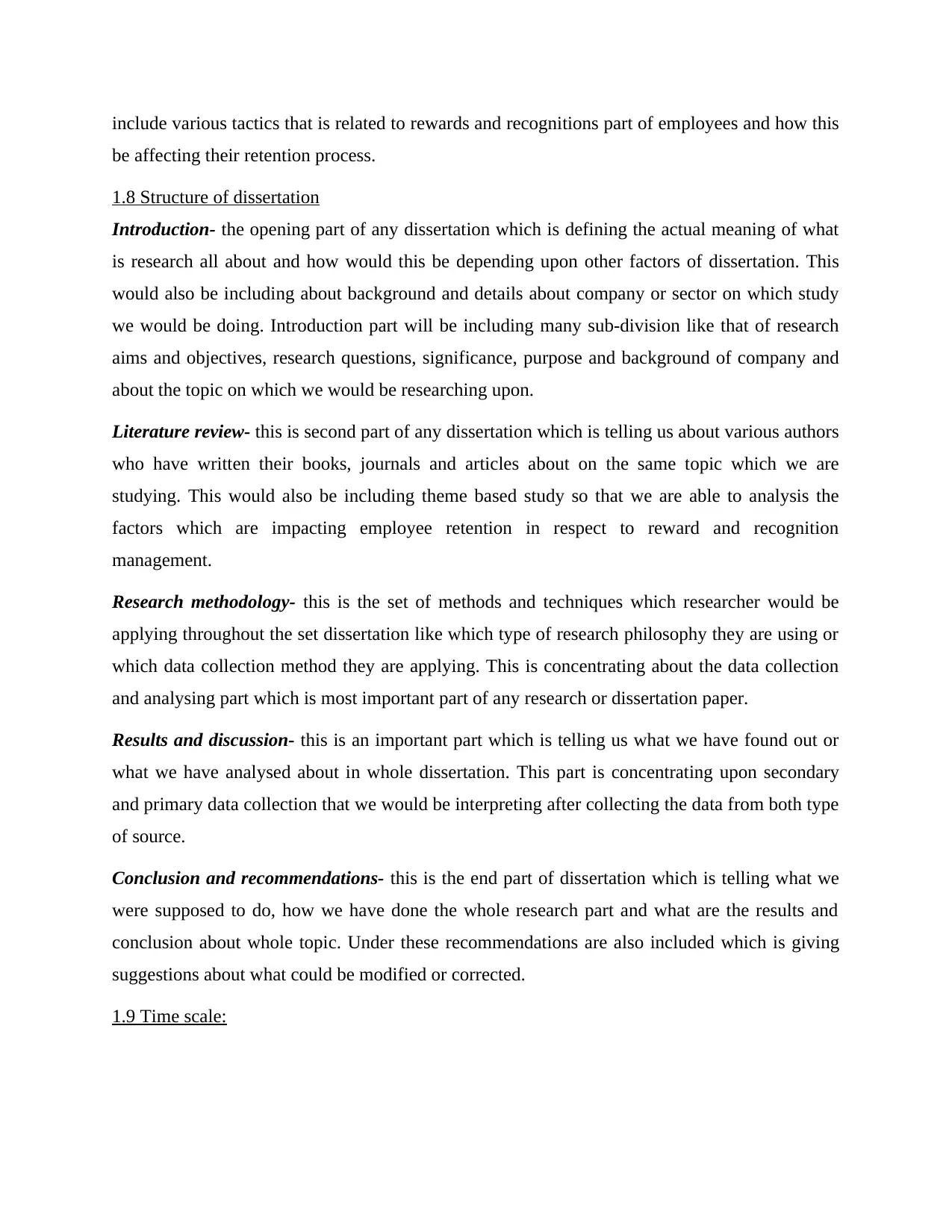
include various tactics that is related to rewards and recognitions part of employees and how this
be affecting their retention process.
1.8 Structure of dissertation
Introduction- the opening part of any dissertation which is defining the actual meaning of what
is research all about and how would this be depending upon other factors of dissertation. This
would also be including about background and details about company or sector on which study
we would be doing. Introduction part will be including many sub-division like that of research
aims and objectives, research questions, significance, purpose and background of company and
about the topic on which we would be researching upon.
Literature review- this is second part of any dissertation which is telling us about various authors
who have written their books, journals and articles about on the same topic which we are
studying. This would also be including theme based study so that we are able to analysis the
factors which are impacting employee retention in respect to reward and recognition
management.
Research methodology- this is the set of methods and techniques which researcher would be
applying throughout the set dissertation like which type of research philosophy they are using or
which data collection method they are applying. This is concentrating about the data collection
and analysing part which is most important part of any research or dissertation paper.
Results and discussion- this is an important part which is telling us what we have found out or
what we have analysed about in whole dissertation. This part is concentrating upon secondary
and primary data collection that we would be interpreting after collecting the data from both type
of source.
Conclusion and recommendations- this is the end part of dissertation which is telling what we
were supposed to do, how we have done the whole research part and what are the results and
conclusion about whole topic. Under these recommendations are also included which is giving
suggestions about what could be modified or corrected.
1.9 Time scale:
be affecting their retention process.
1.8 Structure of dissertation
Introduction- the opening part of any dissertation which is defining the actual meaning of what
is research all about and how would this be depending upon other factors of dissertation. This
would also be including about background and details about company or sector on which study
we would be doing. Introduction part will be including many sub-division like that of research
aims and objectives, research questions, significance, purpose and background of company and
about the topic on which we would be researching upon.
Literature review- this is second part of any dissertation which is telling us about various authors
who have written their books, journals and articles about on the same topic which we are
studying. This would also be including theme based study so that we are able to analysis the
factors which are impacting employee retention in respect to reward and recognition
management.
Research methodology- this is the set of methods and techniques which researcher would be
applying throughout the set dissertation like which type of research philosophy they are using or
which data collection method they are applying. This is concentrating about the data collection
and analysing part which is most important part of any research or dissertation paper.
Results and discussion- this is an important part which is telling us what we have found out or
what we have analysed about in whole dissertation. This part is concentrating upon secondary
and primary data collection that we would be interpreting after collecting the data from both type
of source.
Conclusion and recommendations- this is the end part of dissertation which is telling what we
were supposed to do, how we have done the whole research part and what are the results and
conclusion about whole topic. Under these recommendations are also included which is giving
suggestions about what could be modified or corrected.
1.9 Time scale:
Paraphrase This Document
Need a fresh take? Get an instant paraphrase of this document with our AI Paraphraser
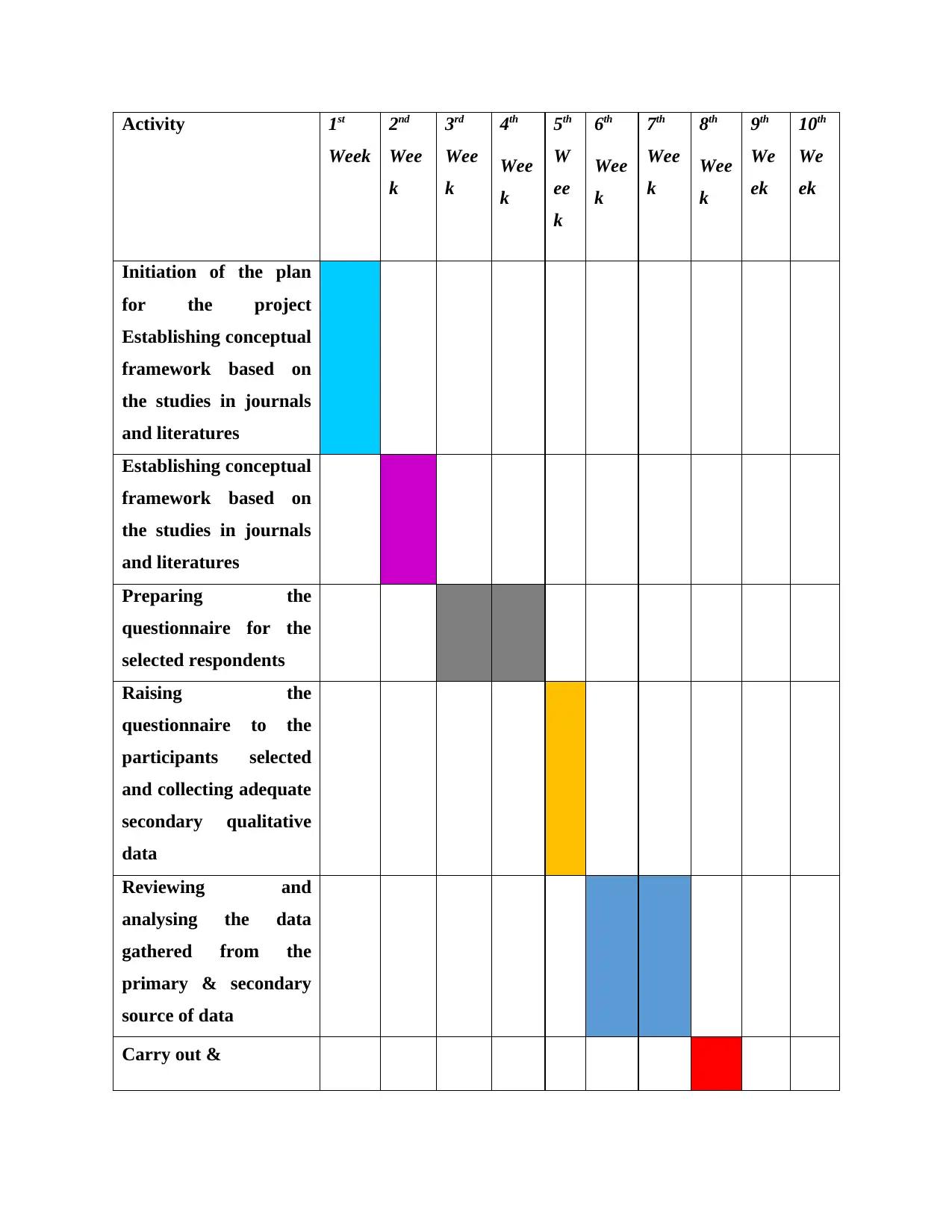
Activity 1st
Week
2nd
Wee
k
3rd
Wee
k
4th
Wee
k
5th
W
ee
k
6th
Wee
k
7th
Wee
k
8th
Wee
k
9th
We
ek
10th
We
ek
Initiation of the plan
for the project
Establishing conceptual
framework based on
the studies in journals
and literatures
Establishing conceptual
framework based on
the studies in journals
and literatures
Preparing the
questionnaire for the
selected respondents
Raising the
questionnaire to the
participants selected
and collecting adequate
secondary qualitative
data
Reviewing and
analysing the data
gathered from the
primary & secondary
source of data
Carry out &
Week
2nd
Wee
k
3rd
Wee
k
4th
Wee
k
5th
W
ee
k
6th
Wee
k
7th
Wee
k
8th
Wee
k
9th
We
ek
10th
We
ek
Initiation of the plan
for the project
Establishing conceptual
framework based on
the studies in journals
and literatures
Establishing conceptual
framework based on
the studies in journals
and literatures
Preparing the
questionnaire for the
selected respondents
Raising the
questionnaire to the
participants selected
and collecting adequate
secondary qualitative
data
Reviewing and
analysing the data
gathered from the
primary & secondary
source of data
Carry out &

Record Research
Discussion and
Conclusion
Final Report
Editing & Completion
Discussion and
Conclusion
Final Report
Editing & Completion
⊘ This is a preview!⊘
Do you want full access?
Subscribe today to unlock all pages.

Trusted by 1+ million students worldwide
1 out of 56
Related Documents
Your All-in-One AI-Powered Toolkit for Academic Success.
+13062052269
info@desklib.com
Available 24*7 on WhatsApp / Email
![[object Object]](/_next/static/media/star-bottom.7253800d.svg)
Unlock your academic potential
Copyright © 2020–2025 A2Z Services. All Rights Reserved. Developed and managed by ZUCOL.




